What Causes Dark & White Spots on Hardwood Floors?
If you are wondering what causes dark and white spots on hardwood floors and how to fix them up, it’s fortunate since you have come to the right place. There are various reasons why dark or white spots appear on your beautiful floors.
Those stains ruin the look of hardwood and maybe the structure, too. Don’t panic since I will tell you why they are there and the way to clean them up now. Let’s scroll down for more information!

Where Do Those Dark Or White Spots Come From?
White stains and dark/black stains are the two most common stains found on hardwood floors. Apart from color, the difference between these two types of stains is their depth.
While the white stains are a problem outside, the black stains reveal the structure’s destruction inside. Now, let’s take a deeper look at their causes.
Causes Of Black/Dark Stains
These dark/black stains show when there is profound destruction inside the floors’ structure. And one reason why they are called dark stains; they indeed somehow look like burnt wood. So, how can these charred-like stains appear on your floors? Let’s check now!
Iron Marks/Stains

To make it short, these can be the stains that are left from the chemical reaction of wood tannins, water, and iron (from the residue of abrasive minerals after the manufacturing process).
This type of stain will appear (under the polyurethane coat) after time, even if you don’t do anything to affect your floors.
Discoloration From Tannins
Trees naturally contain tannins as a defense mechanism against harmful insects and bacteria. This type of acid can quickly form a chemical reaction with your floor finishes, leading to dark/black stains.
Therefore, when your hardwood floors are made of high-tannin trees like oak, walnut, or mahogany (1), the chances that this tannic acid reacts to the finish coat and causes are higher.
Fungi Stains (Sap Stains)

When the stains appear with the color brown or blue, it’s maybe the sign that a particular type of fungus has grown on your hardwood floors. These fungi will develop when there is excess humidity.
Water-Based/Pet Stains
As I said, modern style hardwood floors are water-resistant yet not completely waterproof, and ignoring spills on them can cause permanent damage. It will cause similar problems if you don’t know how to clean the messes properly.
Therefore, the black spots/marks/rings appearing on your hardwood floor may be molded/mildewed or pets’ urine, poop, and vomit. The discoloration from these spills can make your hardwood floors look dull and old really quick.
Chemical Spills Stains
Spills also form these stains, but they are not water-based; they are usually oil, milk, chlorine, acetone, or acetic acid. Now you know that these things can also cause dark stains, so you should be careful with them, too.
Steam Mop
Don’t use a steam mop on your wood floor. It might cause no significant harm to your floors when they are still new and fully protected by the polyurethane coat, but the situation will change if there is any scratch.
The concentrated heat and moisture from the steam mop can creep deeply inside the wood and cause severe effects on it, such as mildew growing (which causes dark stains) or attracting fleas/pests.
Some Other Acceptable Stains: Sticker Stains And Blotchy Stains

These stains are left from several mistakes in the manufacturing processes, which are acceptable since they are only marks on the finish. In short, these are marks/stains of error wood products.
While sticker stains occur because of the marks from the sticky strips used to separate each wood board from the others, blotchy finish stains are caused due to the poor finishing steps accomplished by the producers.
These stains are unremovable; you should check the conditions of your wood boards when they newly arrive at your hand.
Causes Of White Stains
White stains or the common discoloration that are shown on the surfaces of your hardwood floors. These stains are more usually found on lacquered finish hardwood floors than the old styles, oil-coated floors.
Modern style hardwood floors are covered with a polyurethane finish, which helps maintain the glossy sheen and prevents spills or stains quite well. But it doesn’t mean this finish can be “unbeatable.”
Coming back to the main points, what are the causes of these white spots? Here are some most prevalent reasons for that:
Water Spills Or Spilled Stagnant Liquids (Perfumes/ Alcohol/ Medicines/ Juice Spills)
If you leave the spills there and ignore them, they will sneak into the finish layer and be stuck there. Later on, they will become the white or greyish stains that you often see. Applying the wrong cleaning techniques on your floors can also be a reason for these white spots.
Another case is the polyurethane layer of your hardwood floors has already worn off, becoming much thinner after time. Your floors are now exposed to stains/spills and many other factors. And these white spots will appear unconsciously just like that.
Heat (Hot Iron/Pans Or Pizza Boxes)
The high, concentrated heat from pans, iron, or pizza boxes can also leave white marks on your wood floors.

Inappropriate Cleaning Techniques
Choosing the wrong types of chemicals or cleaning utensils can ruin the polyurethane finish and make your floors easily stained.
Pests’ Poop (Spiders)
You do not misunderstand the words; it is truly “pests’ poop.” Sometimes you might find several little white spots appear on your floors, and those are pests or especially spider poops.
Therefore, the lesson concludes here that wiping/cleaning/clearing off any spills immediately when you see them is a must! It helps to preserve the pristine condition of your hardwood floors and also their sheens.
Scratches

Floor scratches seem to be a common issue that can always happen to your hardwood floors, and sometimes they look exactly like some kinds of white spots or dents. You also need to fix it quickly to avoid moisture invasion that can lead to more severe problems.
There Are Some Efficient Ways To Deal With Dark Stains Like A Pro!
Let’s start with the ways to remove dark or black stains! Since the problems might be from the deeper layers of your wood, the fixing measures are also a bit stricter.

A Whole Cleaning Guide
To deal with some kinds of dark stains, don’t wait until the stains get more serious! Time is gold, and you should see these instructions!
What to have:
- 100 grit sandpaper
- Steel wool
- Protective coating (varnish/wax/polyurethane or lacquer)
You should prepare something:
- Chlorine bleach
- Second bleach step options: baking soda, white vinegar, hydrogen peroxide, oxalic acid
- Soft cloths
- Clean, damp sponges (+water)
- Protective coating (polyurethane/lacquer/wax or varnish)
Notes: To be safe, you should refer to the floors’ manufacturers’ suggestions to choose the most appropriate type of bleach.
Step 1: Clear The Dust, Dirt, And Debris First
Before moving to other clearing or cleaning steps, a dirty floor will be annoying, and all the debris on it can also impede your movements or the effectiveness of the chemicals.
Therefore, use a broom to quickly get rid of dust, debris, or particles and prepare a clean surface for the next steps.
Step 2: Using Sandpaper And Steel Wool

Use the sandpaper to scrub the stains and follow the wood grain gently. After that, use the steel wool to blend the edges around the scratched stains.
How to use sandpaper on this application, let’s find out!
Step 3: Bleach The Stains
Bleach is super helpful in lightening the dark stains but overdoing it can lead to another severe problem. Therefore, unless there is absolutely no way around it, you can try this method. Yet, you need to follow the steps carefully.

Dampen a cloth with chlorine bleach and apply a thin chemical layer to the stains. Leave the bleach there for a few hours. Remember to check the stains’ status frequently to see if they are gone or not.
Now, use the damp sponge prepared previously to wipe and take off the bleach residue. Then choose one chemical in the “second bleaching step options” list above, apply a thin coat onto the stains, do a gentle rubbing, and use a clean cloth to do that.
Option 1 – Re-applying bleach: After the first bleaching step with bleach, you can apply another layer of the chemical on the stains and leave it there overnight.
Option 2 – Baking soda: assists you well in household cleaning and can remove stains and odor capturing (2). It will work better when mixed with vinegar to make a cleaning paste.
Simply put the baking soda paste directly on the stains and leave it dry out naturally in a couple of hours. It will also absorb the unpleasant odor for you without asking.
Option 3 – White vinegar: help with deodorization and removing the dark stains well. Dilute 1 cup of white vinegar with a whole bucket of clean, warm water to create the solution. Soak a clean cloth with vinegar and scrub directly on the stained area.
Let the solution sit on your floor surface for a couple of minutes. After that, use the force of one finger to re-scrub the stains. You must notice not to ever use undiluted vinegar directly on your hardwood floors.
Option 4 – Hydrogen peroxide: It also helps with removing unpleasant odors and stubborn stains. But this chemical requires a longer time to make a complete de-stain reaction (8 hours or more).
Option 5 – Oxalic acid: has a unique ability to deal with water-based stains or rust, lightening dark/grayish marks on wood floors. Blend some water with oxalic acid to form a fine paste, then spread and rub the paste evenly on the stains with a brush.
Before wiping the chemical paste off your floor, you should let it sit for several hours. Redo all the steps again until you love the outcome.
Yet, this chemical is a dangerous toxin to humans (can cause headache, dizziness, nausea, or worse) (3), so you should follow the guidelines strictly to use it.
Note: To be safe, you should refer to the floors’ manufacturers’ suggestions to choose the most appropriate type of bleach.
Step-by-step how to apply polyurethane to recoat your hardwood floors.
Step 4: Use Stain Markers To Color The Scratched Areas
Stain makers will not cause any trouble to you in this case. Conversely, they will help you to recolor the scratches to match the wood color.
Step 5: Apply The Protective Coating/New Finish On The Affected Area
After all the sanding and bleaching, your hardwood floor surfaces now definitely have no more protective layer on them. After staining the bleached areas, you should recoat another protection layer onto it.
You can use any type of refinishing product that matches the other parts of your floor, such as polyurethane or wax.
How To Deal With Dark Stains From Pet Urine
You should get rid of pet urine quickly whenever the situation happens. Once leaving it there for too long, dark stains appear and only get worse to deal with after time.

You Should Prepare:
- Baking soda
- Hydrogen peroxide
- White vinegar
- Soft rags/cloths
- Container
Method 1: With Only Baking Soda
Below is how to get the work done straightforwardly.
Step 1: Generously sprinkle some baking soda on the stains.
Baking soda will form a chemical reaction inside pets’ urine and separate it from the wood’s surface.
Step 2: Let the powder sit there for a while.
Step 3: Use a soft rag to wipe the excess baking soda on the hardwood floor. If the result does not satisfy you, you can redo step 1 several times.
Method 2: Combine Three Components
You can also apply all three components to receive the best cleaning effects. Let’s make some cleaning solutions with vinegar and baking soda (hydrogen peroxide should be used separately in another step).
Solution mix: Mix well 1 cup of white vinegar with 1 cup of water in a container.
Alternative mix: Create a baking soda paste by mixing vinegar with baking soda. Adjust the amount of these two, pinch by pinch, to have a perfect paste-like texture.

How to do:
Step 1: Dampen the soft cloth with the vinegar solution or take some of the alternative paste to apply them to the stains.
Step 2: Gently rub the affected areas until you can detect the changes. Leave the stains with the solution as-is to air-dry a bit.
Step 3: Use another cloth to take out the solution mix/paste residue.
If the stains are so stubborn and are still there, look at the next step.
Step 4: Pour some hydrogen peroxide onto another clean rag/cloth and cover it over the stains. Leave it there overnight and let the chemical do all the rest.
If you are still unsatisfied with the result, repeat all the steps all over again.
Another Option To Clean Pet Urine: Sanding And Sealing
Sometimes, using chemicals won’t work too well on stubborn pet urines, and you might ask for another physical method like sanding. Simply use sandpaper to rub the stained area to clear all the dark marks.
Don’t worry about the scratches; you can do the resealing after done with the previous step.
How To Get Rid Of White Stains On Hardwood Floors
Dealing with white stains can be much easier than with black stains, yet you still need to be careful not to worsen the problems. Take a look at these solutions below to choose the most appropriate ones and apply them to your wood floors.
1. Mayonnaise
Can you clear off the water-based white spots with mayonnaise? Let’s verify it with the instructions below!

Something You Need:
- Absorbent paper towels
- A soft, fabric cloth
- A spoon
- A plastic/rubber spatula
- Mayonnaise
- Furniture oil
How to Do:
Step 1: Blot up as much of the running liquid as you can if there is any. If there is any water in the surrounding, remove it, too.
Step 2: Spread a moderate amount of mayonnaise onto the white stains with the plastic spatula.
Why spatula? It is because the elasticity of the spatula can help you to spread the mayonnaise more evenly. In case you are not familiar with using it, a plastic spoon is fine either.
Step 3: Wait! Leave the mayonnaise there for a minimum of 30 minutes. If you have more time, 1 hour or overnight will bring a better result.
Make sure your mayonnaise covering is always damp. If you see them getting drier, re-smear another layer onto the previous one.
Step 4: Use the fabric cloth to take the mayonnaise out of your hardwood floor.
You can do this step several times with other clean cloth to ensure taking all of the mayonnaise off your floor.
Step 5: Re-polish your floor with some high-quality furniture oil.
Secret reveal: If you are wondering how mayonnaise can do such magical work like that? The secret lies in its components. Mayonnaise is made of vinegar, oil, lemon juice, and eggs.
Vinegar and lemon juice are super helpful in clearing stains, while oil can retain the glossy sheen of your floors. And not only to white stains, but mayonnaise can also help with black stains removal.
2. Sandpaper Or Abrasive Pads

Before applying any cleaning chemicals or liquids on your hardwood floors, try some of these physical measures first.
With the easy white stains (water stains), you can try gently scraping or scrubbing them with sandpaper or some kinds of abrasive pads such as steel wool.
Don’t be vigorous, or you will scratch your floor. Never forget to recoat your floor with furniture oil or protective coating.
3. Steel Wool And Lemon/Mineral Oil
If the previous way doesn’t work, try a bit harder with this method with steel wool and some additional components. It also works best on water stains.

What to Have:
- A steel wool
- Lemon oil/mineral oil
- Paste wax
How to Do:
Step 1: Pour a bit of lemon/mineral oil onto your steel wool, don’t let it be too watery or have liquid drippings.
Step 2: Gently scrub the stains following the back and forth movement; remember to control your force.
One drawback of this method is removing the floors’ finish together with the white spots. Therefore, lemon or mineral oil is used to replace the polishing effect in those areas.
Step 3: Buff the scratches after covering them with the paste wax. This step helps to make your floors take back their pristine look.
Another Use Of Mineral Oil
This way is super straightforward to apply, and you should try it with light water stains.
You should have:
- Mineral oil
- A soft microfiber rag/towel/cloth

What to do:
Step 1: Dampen your rag with a bit of mineral oil.
Step 2: Spread oil onto the white stains using that rag. A thin layer will be great. Redo this step the second time after a few minutes.
Step 3: Leave the oil there and wait for the oil to do its work; the de-staining process might take up to 24 hours.
Step 4: Once you see the stains are easier to take off, use a clean rag to take the white stains out.
4. Salt And Olive Oil
Another user-friendly solution to remove white stains is making salt and oil paste. Let’s see how to get the work done.

What You Will Need:
- Salt
- Olive oil
- A soft cloth/cotton pad
Solution paste: Mix 1 teaspoon of salt with 1 teaspoon of olive oil to create a nice paste.
Alternative: Mix 1 teaspoon of salt with a bit of water and stir them well to make a paste.
How to do:
Step 1: Apply the paste onto the stains and gently scrub it with a soft cloth.
Step 2: Leave it there for around 15 or 20 minutes.
Step 3: After that time, use another cloth to remove the salt and oil on your floor’s surface.
5. Vinegar And Olive Oil
Vinegar appears in almost all household stain-cleaning, and here are some things you will need this time:
- 1 cup of white vinegar
- 1 cup of olive oil
- Cotton cloths
Solution mix: Blend 1 cup of white vinegar with 1 cup of olive oil; you can adjust the amount following the ratio 1:1.
Alternative mix: Also following the ratio 1:1, mix 1 cup of vinegar with 1 cup of water. Put them all in a spray bottle to spray on your floor later on.

How to do:
Step 1: Dampen a soft cloth with the solution mix and slightly scrub the stains with it. Continue to clean until you see the white stains are less detectable or faded.
Step 2: Polish your hardwood floor with another vinegar-solution soaked cloth.
After doing all of these steps using this kind of solution, your stains can be removed, and the glossy look of your floors’ surface will also be back. Don’t hesitate and give it a go!
Detailed guidance on cleaning white spots on your hardwood floors with vinegar solution!
6. Baking Soda
Aside from vinegar, baking soda is also a great cleaning component. Its mild bleaching ability can help to deal with stains.

In This Case, you Should Prepare:
● 1 tablespoon of baking soda
● Some water
● Cotton/microfiber cloths
● Furniture polish
Solution paste: Create the baking soda paste by stirring 1 tablespoon of baking soda with moderate water.
How to Do:
Step 1: Apply some of the paste on the stains by using the cloth.
Step 2: Gently scrub the stained area so the baking soda can do its work thoroughly. Leave the paste to sit for a couple of minutes.
Step 3: Use another damp cloth to take the solution out of your hardwood floor.
The stains are supposed to be cleaned from this step. In case they don’t, redo from step 1 and leave the baking soda paste there overnight or up to 24 hours.
Remember to use a damp cloth to remove the paste residue and make sure the cleaning area is dry afterward.
Step 4: Put some furniture polish on that area and let it dry naturally. It will help to bring back the pristine look of your floor.
7. Toothpaste
Toothpaste also can remove dirt and stains; you can verify it yourself when doing daily tooth brushing. Then, there is no reason not to give it a try in cleaning light stains on your floors.

What You Will Need:
- Toothpaste (non-gel is preferred)
- An unused toothbrush (a soft cleaning brush)
- A clean cloth
- Water
How to Do:
Step 1: Put some non-gel toothpaste directly on the white stains.
Step 2: Gently scrub the stains with the toothbrush, don’t scrub the un-stained places around the stains. You can accidentally leave scratches on them. Continue cleaning until you are satisfied with the result.
Step 3: Remove the toothpaste out of your hardwood floors with the damp cloth (+water).
8. Applying Heat
Heat can cause white spots but can also magically eliminate them on hardwood floors. Trust me! Below are two possible ways, and you can verify them yourself.
What you need:
- A hairdryer
- Clean cloths
- An iron box
Method 1: Using A Hairdryer
Set the lowest heat mode on your hairdryer and blow the hot air directly onto the marks. Continue doing that until you see the white marks fade away.
Using a hairdryer to dry water stains really works, and here is how you should do it.
Method 2: Using An Iron

Here are the steps to do it.
Step 1: Place a clean cloth on the white stain and adjust the iron box into the lowest mode.
Step 2: Iron your stains through the cloth carefully.
Step 3: Check the result under the cloth frequently to know when to stop, or you should continue to repeat the movement.
Note: Don’t use steam iron! If your iron contains liquid, take the liquid out before ironing.
9. Hydrogen Peroxide
When it comes to cleaning hardwood floors, you should never ignore hydrogen peroxide. It not only helps with removing stains and bringing back cleanliness, but it is also safe for humans or pets and helps to eliminate bacteria, fungi, and viruses.
Those stubborn pet stains or mud are also not a challenge with the incredible bleaching ability of this chemical. Yet, don’t overuse it on hardwood floors with a darker finish; it might bleach that color into light yellow or white.

What to have:
- Hydrogen peroxide
- Cotton/wool/soft microfiber pads or cloths
- Plastic cup/container
- Clean cloths
Preparation: Put a bit of hydrogen peroxide into your prepared plastic cup.
How to do:
Step 1: Dampen a cotton pad with hydrogen peroxide, put the pad directly on the stains. You don’t need to wring out the excess water.
Step 2: Wait for at least 5 or up to 10 minutes. Just let the chemical do the bleaching and remove the stains.
Step 3: Take the pad away from the stains, clear up the excess chemical with a clean cloth.
Step 4: Let your floor dry naturally with air, or use another cloth to blot up the moisture and preserve the pristine look for your wood floor.
10. Mineral Spirits
You need to be careful when using mineral spirits on your floors; its bleaching ability is more intense than hydrogen peroxide that can take off the wax layers – because of that, considering using a tiny bit of mineral spirits is enough. Let’s see the detailed guide here!

What to have:
- Cotton pads/soft scrubbing pads/cloths
- Sandpaper
- A spray bottle
- Mineral spirits
Preparation: Put a moderate amount of mineral spirits into the spray bottle.
How to do:
Step 1: Apply a tiny amount of mineral spirits onto the stains with your spray bottle.
Step 2: Use the cotton pads or cloths to scrub the stains gently.
Step 3: Let the chemical sit on the stains for 5 to 6 minutes.
Step 4: Never forget to use other clean pads/cloths to remove the chemical residue.
Step 5: Leave your floors to air-dry completely (it only takes a few minutes).
Step 6: Use sandpaper to sand the affected area a bit to refinish the process.
11. Floor Cleaners And Stain Markers
There are thousands of floor cleaners products in the market, and you can easily find one near your house. You can refer to the suggestions of your floors’ producer to choose the most suitable one.
After that, you only need to follow the cleaner’s packaging guidelines and make the solution liquid. And you should use a way to fix white dent scratches on your hardwood floors.

What you will need:
- Soft cloths/rags/towels
- Abrasive or scouring pads
- Steel wools
- Polyurethane or other protective coatings
- Wood filler (choose ones that have similar colors to your floors)
- Wax wood (stick, choose the color that matches the floors’)
- Dull knife
- Mineral spirits
- A hardwood stain marker (choose ones that have similar colors to your floors)
- Floor cleaner (specialized for hardwood)
- A soft brush
- Water
Solution mix: Follow the manufacturers’ instructions to dilute your floor cleaner.
Note: You should check the wood filler or marker’s color in an inconspicuous place on your floor to check if its color is matched or not.
Step-by-step to do:
Step 1: Dampen your cloth or rag with the solution mix (wood floor cleaner + water).
Step 2: Remove all the dirt, dust, debris away from the scratches’ surroundings.
Step 3: Rinse the left solution off the floors with a damp clean cloth (+water). Let those areas dry before moving on to the next step.
Choose method 1 or 2 below based on the severity of the scratches to have the best covering result.
Option 1: With Light Scratches (Not Too Dent)

Step 4: Color the scratches with the stain marker until they are fully covered.
If the first layer doesn’t work and the stains are still visible, you should dampen your cloth/rag with some mineral spirits to wipe it off and give them another go.
Option 2: With Severe Scratches
Step 4: Lightly rub the scratches with dampened abrasive pad or scouring pad with mineral spirits.
You need to take out the polyurethane coat over your floor before moving to the scratches fixing steps.
Step 5: Use the damp cloth (+water) to gently remove the debris/dust after the first step and continue to wait until those places are dry.
Step 6: Pour a fingertip of wood filler on your hand and gradually apply it to the scratches. Make sure to eliminate all the bubbles on the filled scratches.
If you only have a wax stick, melt it up and fill in the scratches. If you accidentally leave a few wax drops on your floor, simply remove them with a dull knife. It will take around 10 minutes for the wax to dry, then take off the wax spill quickly before that.
After filling and coloring the stains, let’s move to the coating step (apply both methods).

Step 7: Blend the edge of the stains gently using the steel wool.
Step 8: Use the brush to re-apply the protective coat for your floors. If your floors are coated with polyurethane, apply a thin layer of it on the scratched area.
But in case your hardwood floors are not coated with it, you can still use the other types of protective coating to refinish the marks.
How To Prevent Dark And White Spots On Wood Floors
If you protect your floors from black or white stains, no matter what type of hardwood floor you have, you have to keep these rules in mind.
Rule 1: Clean Up The Spills Immediately!
Whenever spills happen, your first reaction should be finding something to clean up before the running liquid creeps deeper to the edges or gaps and ruins the floor.
If some spills leave stains or tints, use some of the above recommended stain-removing methods to get rid of them. I suggest referring to baking soda, vinegar, or toothpaste.
Note: Every time you put food or drink on your hardwood floors, remember to use the coasters to avoid heat and spills that directly affect your floors’ surfaces.

Rule 2: Never Let The Moisture Stay On Your Floors’ Surface.
Either spills or moisture after cleaning, you always need to remember to dry them up and should not let them sit for too long on your hardwood surfaces. You can try some way to dry the damp area faster, like using electric fans or ceiling fans.
Opening the doors and windows to have the air inside your house ventilate better can also help to dry your floor.
Wet objects should not be placed on wood floors. Some things that carry much humidity, like plant pots, are also included.

Rule 3: Avoid Applying Heat On Your Wood Floors.
The heat can form white stains from the hot pizza box or hot pans; therefore, never put those things directly on your floors. Always place something as a spacer like carton pieces, thick fabric cloths, or oven mittens.
You should also avoid using a steam cleaner on your hardwood floor too.
Rule 4: Protect Your Hardwood Floors With Carpets, Area Rugs, Or Felt Pads.
Carpets and area rugs are used to embellish your living area and protect the weaker or sensitive parts of your flooring from damage or unwanted scratches.
You should be aware of furniture legs, too; they should not be directly in contact with your floors. I suggest using felt pads like a spacer separating them.

Rule 5: Clean Your Hardwood Floors Regularly.
You should do the mopping (with the proper solution, referring to some choices above), vacuuming (no beater bar at all costs), or sweeping (with soft bristles broom) frequently.
They will help keep the hardwood floor surfaces clean, dry, with not much debris or particles that can scratch your floors, and reduce the chance of having old, stubborn stains. When mopping, I suggest using microfiber and doing the mopping once every week.
Warning: No wet mopping; damp mopping is more than enough!
Rule 6: Never Leave Mold To Be Overgrown!
One of the main factors that can lead to dark stains on your hardwood floors is molds/mildews overgrown. To avoid this, besides minimizing the humidity on, in, and under the floors, you need to get rid of molds once you see their signs.
You have known how terrible the problems that molds can cause to your hardwood floors so that this rule should be kept in your mind.

Rule 7: Don’t Walk With Dirty Shoes On Your Floors.
Using mats in front of the entrance can help remove most of the dirt, soil, or particles from your shoes before stepping on the wood floors. It would be better if you changed to indoor slippers whenever you enter your house. You should wear shoes outdoors only.
Note: Your pets’ paws should also be clean and dry before letting them go inside. You can wipe their paws with a cloth or simply put on some footwear for them before going out and take them out before going inside.
Rule 8: No Spider Webs Inside Your House.
Spider poops are also a cause of white spots on your wood floors, so make sure you also clean up all the corners or any dark places in your house to reduce spiders inside.

Rule 9: Potty Train Your Pets.
If you have a pet, you should potty train them and avoid any unwanted accidents that happen again and again all the time. Although you can clean it in a blink, the stains and the odors left are absolutely annoying.
Easy peasy ways to potty-train your lovely pets you might want to know.
Rule 10: Recoat Your Hardwood Floor With Sealants Such As Polyurethane Sometimes.
This finish will weaken after time, and once it wears off, the stains can stay in no time. Because of that, recoating your floors occasionally can help to preserve their stain-resistant ability.
FAQs
If you still have questions about dark and white stains on wood floors, let’s check these frequently asked questions and find the answers to your concerns below!
It’s Time To Clear Up The Stains On Your Hardwood Floors!
So, what is the problem with your hardwood floors? Knowing the causes of your troubles and fixing them is essential if you don’t want to make the same mistake twice.
I have also recommended several ways to get rid of the black or white stains, hope that they will assist you well. If you have other tips or methods that work, please leave a comment and share them with me.
Don’t forget to share my tips today with your loved ones; your supporting action will be my huge motivation.


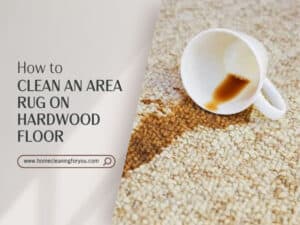
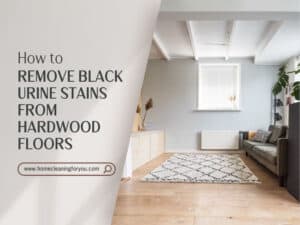
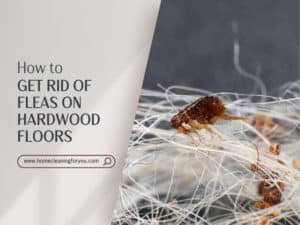
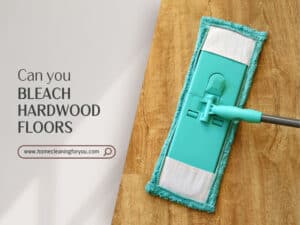
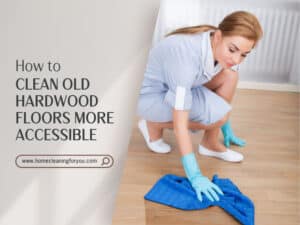
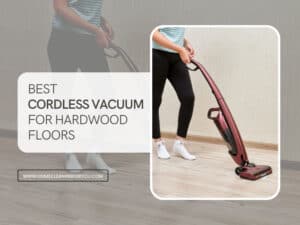
Samantha Lee
Head Cleaning Expert
Expertise
Professional Home Cleaning, Green Cleaning Techniques, Stain Removal & Fabric Care, DIY Home Maintenance & Organization, Sustainable Cleaning Products, Home Care for Busy Lifestyles
Education
University of Denver
Samantha Lee is the Head Cleaning Expert at HomeCleaningForYou.com, specializing in eco-friendly home care. She holds a Bachelor of Science in Environmental Science from the University of Denver, focusing on sustainable cleaning solutions.
With expertise in green cleaning, stain removal, and DIY home maintenance, she helps homeowners keep their spaces fresh and chemical-free. Samantha has been featured in lifestyle publications and has partnered with brands promoting natural cleaning products.
She also shares practical tips through her blog, online courses, and workshops. Passionate about sustainability, she enjoys testing new eco-friendly cleaning methods and spending time outdoors.